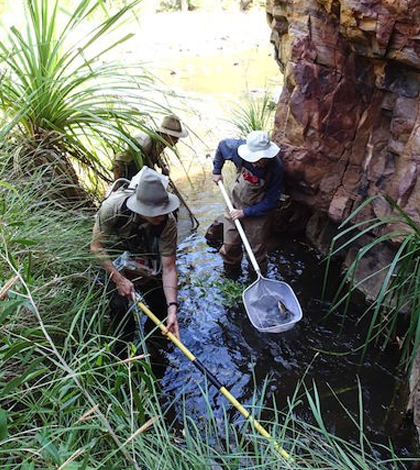The Kimberley: Australia’s Wild West
 Landscape in the Kimberley region, a heavily eroded rock formation of sand and pebbles (Bangle Bangle Range) (Credit: W. Bulach CC BY-SA 4.0)
Landscape in the Kimberley region, a heavily eroded rock formation of sand and pebbles (Bangle Bangle Range) (Credit: W. Bulach CC BY-SA 4.0)While the western portion of many countries have become domesticated, some parts of the world still have a largely unexplored wild west. Australia’s northwestern region, referred to as the Kimberley, is an ancient and largely under-researched expanse of wilderness in Australia. The region is mountainous evidence of the monsoonal climate that has carved out steep ridges in the northern territory and flatter areas in the south as a result of the tides. The region has been largely inaccessible to researchers due to its geography and; therefore, limited current understanding of the Kimberley.
The Kimberley: Wild But Not Protected
Despite the lack of research on the region, the Kimberley is recognized as being incredibly important for Australia and global biodiversity. The World Wildlife Foundation reports that in the Kimberley, there are an approximate 65 species found nowhere else on earth. The area is made up of tidal mudflats, coral reefs, tropical waters, forested areas and grassy regions that host a variety of terrestrial creatures.
Furthermore, the area holds cultural significance to various indigenous groups in Australia. This is a point of particular concern since, while the region has been largely isolated and not much is known, it has been taken advantage of and is at risk of further harm thanks to modern-day climate stressors. The WWF shares, “Large, uncontrolled, hot wildfires, feral species and an exploitative approach by big industry are impacting upon the north’s rare habitats on land and at sea.”
Despite the area’s ecological and cultural significance, large industries have taken an interest in the region, wanting to take advantage of the natural resources found there. However, this land use would not come without a price—instead, it would run the cost of losing a unique pocket of land that has been able to thrive without interruption.
Reasons to protect and conserve the region grow every day as scientists make new discoveries and interest groups are able to populate the media with photos and messages of how pristine and wild the Kimberley is. Not only is the landscape breathtaking, but the wildlife located there can be found nowhere else in the world- with new species still being discovered. The WWF reports that the Kimberley is home to snubfin dolphins, dugongs, golden bandicoots, greater bilbies, Gouldian finches, rare marine turtles and local corals.

Researchers conducting fieldwork in the Kimberley. (Courtesy of the University of Melbourne)
In 2016, researchers looked more closely at the freshwater areas of the region as these habitats are often neglected. The team was able to identify 20 new species in the Kimberley’s freshwater waterways. The team’s discoveries, outlined in a report published by the journal Global Ecology and Biogeography, are collectively the single biggest addition to Australia’s freshwater fish inventory since official record-keeping began.
The new fish species fall into one of three categories: There are 16 Terapontidae (grunters), 3 Eleotridae (gudgeons), and 1 Atherinidae (hardy heads). The freshwater ecosystems of the Kimberley are among some of the poorest known and least researched in Australia, say scientists at the University of Melbourne. If the number of known fish species in the region can be doubled in a few short years, researchers say the area must hold much more biodiversity than previously thought. As the region continues to be researched, more species will be discovered and identified, further bolstering conservation efforts.
Conclusion
The Kimberley region of Australia may be unstudied and wild but that does not absolve it from human impacts. Instead the area is at risk of becoming a source of resources for various industries seeking to make a profit. Continuing to gather valuable data on why the region is so unique is one way researchers can do their part and protect the environment for the sake of cultural and ecological significance.


0 comments